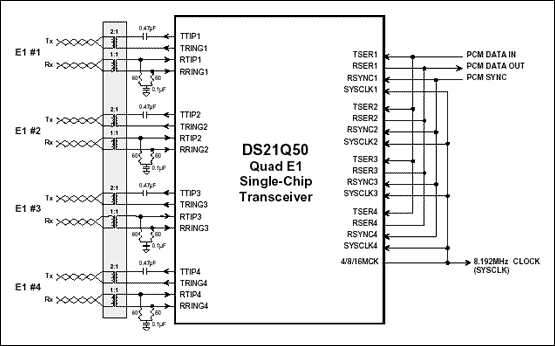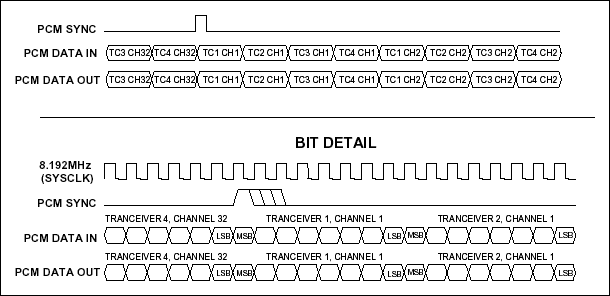

Simple, Low-Cost, 4-Port E1 De
通信设计应用
65人已加入
描述
Abstract: Application note 376 provides the hardware and software requirements for using the DS21Q50 as a quad E1 transceiver. Two significant features are included for this type of application, Interleave Bus Operation (IBO) and a system clock synthesizer. IBO mode allows up to eight E1 data streams to be multiplexed into a single high-speed PCM bus. The system clock synthesizer can create a high-speed backplane clock based on the recovered clock form any of the E1 lines or an external reference clock.

Figure 1. Four port E1 transceiver using DS21Q50.
Notes:
Table 1. Register Settings for 21Q50 4-Port Design
Where:
TC#1 = Transceiver #1 (TS1,TS0 = 00)
TC#2 = Transceiver #2 (TS1,TS0 = 01)
TC#3 = Transceiver #3 (TS1,TS0 = 10)
TC#4 = Transceiver #4 (TS1,TS0 = 11)

Figure 2. PCM Bus functional timing diagram.
打开APP阅读更多精彩内容
Overview
The DS21Q50 is a quad E1 transceiver optimized for high-density termination of E1 lines. Two significant features are included for this type of application: the Interleave Bus Option (IBO) and a system clock synthesizer. The IBO allows up to eight E1 data streams to be multiplexed onto a single high-speed PCM bus. The system clock synthesizer can create a high-speed backplane clock based on the recovered clock from any of the E1 lines, or an externally applied reference clock. Each of these features is accomplished without additional logic components. This document details one specific hardware and software implementation to take advantage of these features for a 4-port E1 design.Hardware Configuration
Figure 1 shows an example application of the DS21Q50 in a 4-port design. In order to ensure data integrity in IBO mode, all clock and sync signals should be phase-aligned. The receive elastic store for each of the four transceivers must be enabled, and they should all receive the same frame-reference pulse (RSYNC) and 8.192MHz system clock (SYSCLK). In this case, the phase-locked frame pulse is provided by the system backplane, and the 8.192MHz clock is provided by the 21Q50's system-clock synthesizer. Note that the 8.192MHz clock can be created internally from any of the four E1 line recovered clocks. In IBO mode, the DS21Q50 can create the transmit clock (TCLK) for each E1 formatter by dividing down the applied SYSCLK.
Figure 1. Four port E1 transceiver using DS21Q50.
Notes:
- Schematic does not include line protection components.
- For compact applications, an octal transformer can be used such as the Pulse T1068.
- This circuit can be software-configured for either 75½ or 120½ E1 applications without changing component values:
- IRTSEL in CCR5.4 determines receiver termination resistance
- L0-L2 in LICR determines transmitter pulse shape
Software Configuration
Table 1 shows some of the critical register settings necessary to initialize the DS21Q50 for operation as described above. Note that Table 1 might not represent the complete register listing required for a customer application. The reader is encouraged to refer to the device data sheet for further information regarding the flexibility of the DS21Q50. It is good practice to clear all 21Q50 registers at power-up, before initializing the device with the desired settings.Table 1. Register Settings for 21Q50 4-Port Design
| Setting | Location | Description |
| The following settings apply to all 4 ports (transceivers): | ||
| IBOEN = 1 | IBO.2 | Enable IBO operation |
| IBOTCS = 1 | IBO.6 | Transmit clock derived from SYSCLK |
| SCS1 = 1 | IBO.5 | 8.192MHz operation (4 ports on the PCM bus) |
| SCS0 = 0 | IBO.4 | |
| RESE = 1 | RCR.4 | Enable receive elastic store |
| RSIO = 1 | RCR.5 | RSYNC pin is an input |
| RSM = 0 | RCR.6 | RSYNC is in frame mode |
| TSIO = 1 | TCR.0 | TSYNC is an output |
| TSM = 0 | TCR.1 | TSYNC is in frame mode |
| The following settings apply to the specified port (transceiver): | ||
| SCS0 = 1 | TC#1, SCICR.0 | Select the recovered clock from transceiver #1 as the source for the system clock synthesizer |
| SCS1 = 0 | TC#1, SCICR.1 | |
| SCS2 = 0 | TC#1, SCICR.2 | |
| CSS0 = 0 | TC#1, SCICR.3 | Set system clock synthesizer to 8.192MHz |
| CSS1 = 1 | TC#1, SCICR.4 | |
| SOE = 1 | TC#1, SCICR.5 | Enable synthesizer clock output |
| DA0 = 0 | TC#1, IBO.0 | Set transceiver #1 as first device on PCM bus |
| DA1 = 0 | TC#1, IBO.1 | |
| DA2 = 0 | TC#1, IBO.2 | |
| DA0 = 1 | TC#2, IBO.0 | Set transceiver #2 as second device on PCM bus |
| DA1 = 0 | TC#2, IBO.1 | |
| DA2 = 0 | TC#2, IBO.2 | |
| DA0 = 0 | TC#3, IBO.0 | Set transceiver #3 as third device on PCM bus |
| DA1 = 1 | TC#3, IBO.1 | |
| DA2 = 0 | TC#3, IBO.2 | |
| DA0 = 1 | TC#4, IBO.0 | Set transceiver #4 as fourth device on PCM bus |
| DA1 = 1 | TC#4, IBO.1 | |
| DA2 = 0 | TC#4, IBO.2 | |
Where:
TC#1 = Transceiver #1 (TS1,TS0 = 00)
TC#2 = Transceiver #2 (TS1,TS0 = 01)
TC#3 = Transceiver #3 (TS1,TS0 = 10)
TC#4 = Transceiver #4 (TS1,TS0 = 11)

Figure 2. PCM Bus functional timing diagram.
声明:本文内容及配图由入驻作者撰写或者入驻合作网站授权转载。文章观点仅代表作者本人,不代表电子发烧友网立场。文章及其配图仅供工程师学习之用,如有内容侵权或者其他违规问题,请联系本站处理。
举报投诉
- 相关推荐
- 热点推荐
- Using
-
TPS-1 Low-cost Solution Kit-硬件手册 Rev.1.022023-03-15 418
-
MAX24188 pdf( low-cost IEEE 1588 clock )2011-08-24 956
-
BQ26231,pdf(Low-Cost Battery C2010-11-05 1280
-
Agilent 4-Port PNA-L Network A2010-07-23 812
-
Low Cost Frequency Multipliers2010-07-11 780
-
CC1101,pdf(CC1101 low-cost sub-1 GHz transceiver designed)2010-07-06 2105
-
Low-Cost Single Channel AE Sys2010-03-30 992
-
MAX15041 Low-cost, synchronous2009-12-17 1682
-
Low-Cost, Dual SCART Solution2009-09-02 2066
-
DS4426 Low-cost, quad sink/sou2009-08-27 975
-
低成本供应交流-Low-Cost AC Supply2009-04-23 810
-
Low-Cost Anemometer Fights Dus2009-04-18 875
-
MAX15026 Low-Cost, DC-DC Synch2009-02-13 1180
-
DS26514 pdf datasheet (4-Port T1/E1/J1 Transceiver)2008-10-22 1669
全部0条评论

快来发表一下你的评论吧 !

